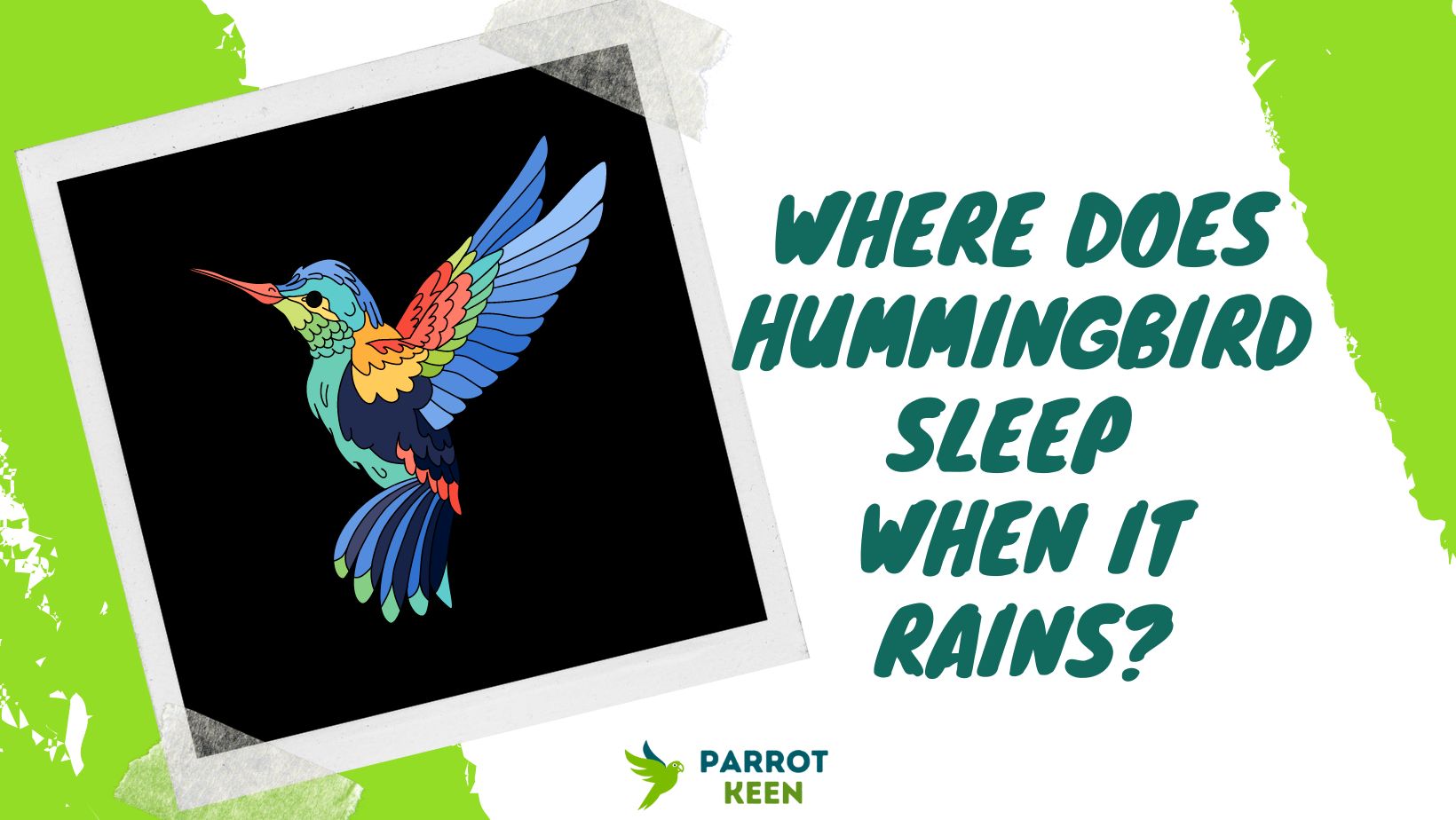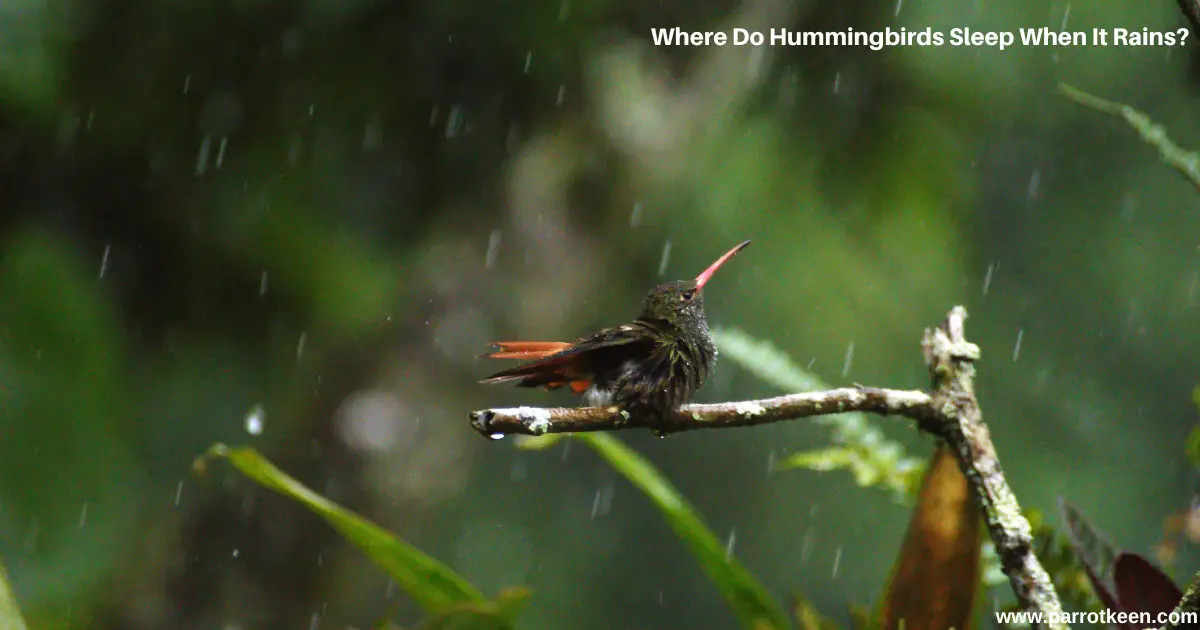
Where Do Hummingbirds Sleep When It Rains?
Hundreds of thousands of years ago, hummingbirds and hurricanes were linked. In the event of poor weather, hummers seek cover in dense foliage on the downwind side of a tree trunk, where they are protected from the elements. When the wind blows, their feet can grip a twig like a vice.
Hummers have a smaller surface area than larger birds, therefore they may have an easier time avoiding the wind.
Most hummingbirds will be unharmed by hurricanes over land, as evidenced by people who describe seeing hummingbirds feeding extensively as the hurricane’s eye is passing over, and by those who see hummingbirds feeding immediately after the storm has passed, but the winds are still severe.
To ensure that the birds have access to sugar water during a storm, some bird watchers in hurricane-prone areas use wire or duct tape to secure their feeders before it hits their area. Remove the duct tape after the storm so that hummingbirds don’t get stuck on it.
Hummingbirds, contrary to popular belief, are tough small creatures that can withstand harsh environments. More dangerous than hurricanes over land are northbound winds from the Gulf of Mexico during migration.
If a bird sets out into a cyclone, it is doomed to be eaten by barracudas. Long-distance migration, including hurricanes, is a major risk for ruby-throated hummingbirds.
We’d have a swarm of ruby-throated hummingbirds if not for the fact that 70-80% of the juvenile birds born this year will die before next spring.
You shouldn’t worry about the birds who don’t make it, as long as you keep your feeders clean.
Where Do Hummingbirds Sleep When It Rains?

While we humans tend to flee the rain, hummingbirds do the same. They seek out any haven from the storm where they can rest comfortably away from the wind and rain.
They often find a secluded location behind the foliage of trees or shrubs, where they will rest their feet on a thin branch for long periods. They don’t care if it’s natural or man-made; as long as it’s protected from the elements, they’re happy.
Adult hummingbirds may ‘sleep’ during the day if the weather turns unfavorable. By ‘sleeping,’ or going into a condition of “torpor,” they can save energy by not feeding as much.
Hummingbirds, on the other hand, prefer to sit on nearby branches and wait for the rain to stop. As soon as the rain subsides, they’ll be back in the air and swooping down for prey.
Hummingbirds aren’t harmed by heavy rain, although they do require more energy to fly when their feathers are wet. They can alter their flight to reduce water intake by increasing the number of wing beats per second or holding their wings at a different angle.
Hummingbirds rarely do this since it takes a lot of energy and they would rather just stay out of the rain. When hummingbirds have to travel through severe rain to locate a place to rest, they use this approach.
What Do Hummingbirds Do When It Rains?
Even in light rain and moderate showers, hummingbirds go about their business as usual. During the summer, they often look forward to a light shower because it can provide some relief from the heat and allow them to fly and feed while using less precious energy.
When the rain comes down harder, they may seek out more protected areas and feed from feeders or other sources of food. If the rain isn’t too heavy, they’ll still be able to take off.
Where Do Hummingbirds Go During Heavy Rain?
However, hummingbirds, like humans, seek cover when the rain becomes more intense. In the event of a storm, they will seek any haven where they may hide from the elements.
As a rule, they prefer to hide among the foliage of trees and bushes with their feet firmly planted on thin branches for long periods. They don’t care if it’s natural or man-made; as long as it’s protected from the elements, they’re happy.
It’s not uncommon for adult birds of the hummingbird family to “sleep” throughout the day due to severe weather.
As a result, they can preserve energy while they are not actively eating by entering a dormant state known as torpor. It’s not uncommon to see hummingbirds perched and waiting for the rain to stop. Then, as soon as the rain stops, they’ll be back in the air, hunting for food.
The feathers of hummingbirds will not be damaged by heavy rain, but they will require more energy to fly when the rain soaks their plumage.
This means they can alter their flight, increasing the number of wing beats per second and holding their wings at an angle that prevents them from absorbing too much water.
However, this is a rare occurrence because it requires a lot of energy, and hummingbirds prefer to avoid rain.
Hummingbirds use this approach only when they must travel through severe rain to locate a place to rest.
Do Humminbird Sleep Upside Down When It Rains?
During the night, hummingbirds decrease their metabolism, heart rate, and breathing rate, allowing them to preserve energy by going into a state known as hummingbird torpor. Hummingbirds use this technique to stay warm throughout the winter months.
Do Hummingbirds Like The Rain?
Hummingbirds have a high metabolic rate, which necessitates them to eat frequently. Consequently, even in bad weather, the birds would still fly out to feed.
They don’t like it when it rains because the wind that comes with the rain may obstruct their movement and make flying difficult compared to normal weather.
Do Humming Birds Fly Around When It Is Raining?
The flight of hummingbirds will be unaffected by light to moderate rain. These resilient birds can fly as they normally would.
Natural design and preening oils help hummingbirds’ feathers repel water, just like other birds’ feathers. They may be able to resist water, but they are not completely watertight.
Hummingbirds, on the other hand, can miraculously shake off water. With just one movement of their feathers, they can remove practically all of the rain from their feathers. When you consider that they can do this at rest and in flight, it’s remarkable.
They’ve seen it in action at various levels of rainfall. The hummingbirds didn’t need to adjust their body position or flight path in the light rain.
However, it has been observed that hummingbirds modify their body position and wing speed when it is raining heavily. – The birds are not harmed by rains in and of themselves.
Even if it’s pouring rain, they’ll make it to their destination just fine. However, because doing so requires more energy and results in less efficient flight, birds will normally avoid it if at all possible.
Why Do Hummingbirds Go Crazy In The Rain?
Even though hummingbirds are known to fly through most weather conditions without difficulty, experts had no idea how they coped with rain.
When NPR reported on the findings of UC Berkeley researchers, they discovered that hummingbirds behave in a way that is very reminiscent of that of dogs. They wiggle their heads like wet dogs to remove all the water from their bodies.
However, don’t expect to be able to see this activity when your hummingbird feeder is full. The slow-motion film showed that they completed this task in 1 second.
The G-force they experience when whipping their bodies and heads can go as high as 34. Formula 1 racing cars, on the other hand, typically only reach a maximum of six on the best days.
Micro air vehicles or better washing machine spin cycles might be developed as a result, according to scientists, as reported by NPR.
Do Hummingbirds Know When Storm Is Coming?
During torpor, hummingbirds can amazingly cling to twigs or other perches with a very firm grasp and find shelter.
No matter how much you turn them, they don’t release go or fall off.
Even amid hurricane-force winds, hummingbirds make a beeline toward the safest havens available. In such a setting, they can withstand even the most extreme weather conditions.
Finding a haven on the leeward side of tree trunks is a skill they have honed over a long period via practice.
There have been reports of hummingbirds feeding on hummingbird feeders in the middle of a storm system. This shows how resilient hummingbirds are in the face of extreme weather.
As a result, spend some time cultivating plants that attract hummingbirds and provide nectar for the insects they feed on.
Also, incorporate amenities such as fresh water for bathing and cooling off, as well as plenty of plants and trees for hummingbirds to perch on and utilize as a refuge when it rains excessively.
To maintain and sustain the hummingbirds that we all enjoy, it is important to have a hummingbird-friendly garden
Conclusion: Where Do Hummingbirds Sleep When It Rains?
In conclusion, hummingbirds are not flimsy or vulnerable. They are, in fact, extremely hardy. When it comes to dealing with wet days, especially strong downpours, they demonstrate their power.
If you’ve learned anything from this piece, please share it with people who may want to read similar articles.

Hi, I am Thersa and Welcome to ParrotKeen, your number one place to get all the information you need about your cute parrot. I hope You Find it useful.
